Interpretation as Introspection: Transforming Narratives of American Art at the Allen Memorial Art Museum
PDF: Kinney and Letvin, Interpretation as Introspection
Lined up as if across a stage, a fashionably dressed family poses in front of an expansive plot of land (fig. 1). A luxurious Greek Revival home occupies the right half of the property. Young trees and plants are scattered throughout a carefully manicured lawn on the left. A white fence enclosing the land protects this meticulously ordered universe from the surrounding forest. Empty trellises along the house await new growth—a sign of optimism in the land and the family’s future in their home. The proud patriarch of this rosy-cheeked family is Bentley Simons Runyan. Born in Knox County, Ohio, Runyan moved to nearby Mansfield in 1847, where he became a hardware merchant and civic leader.1 He commissioned this painting from the English-born artist Frederick E. Cohen (around 1816–1858), who moved to Ohio in 1854 after a varied career in Detroit, where his output ranged from designing stage sets and decorative panels for Great Lakes steamships to painting portraits and historical subjects.2
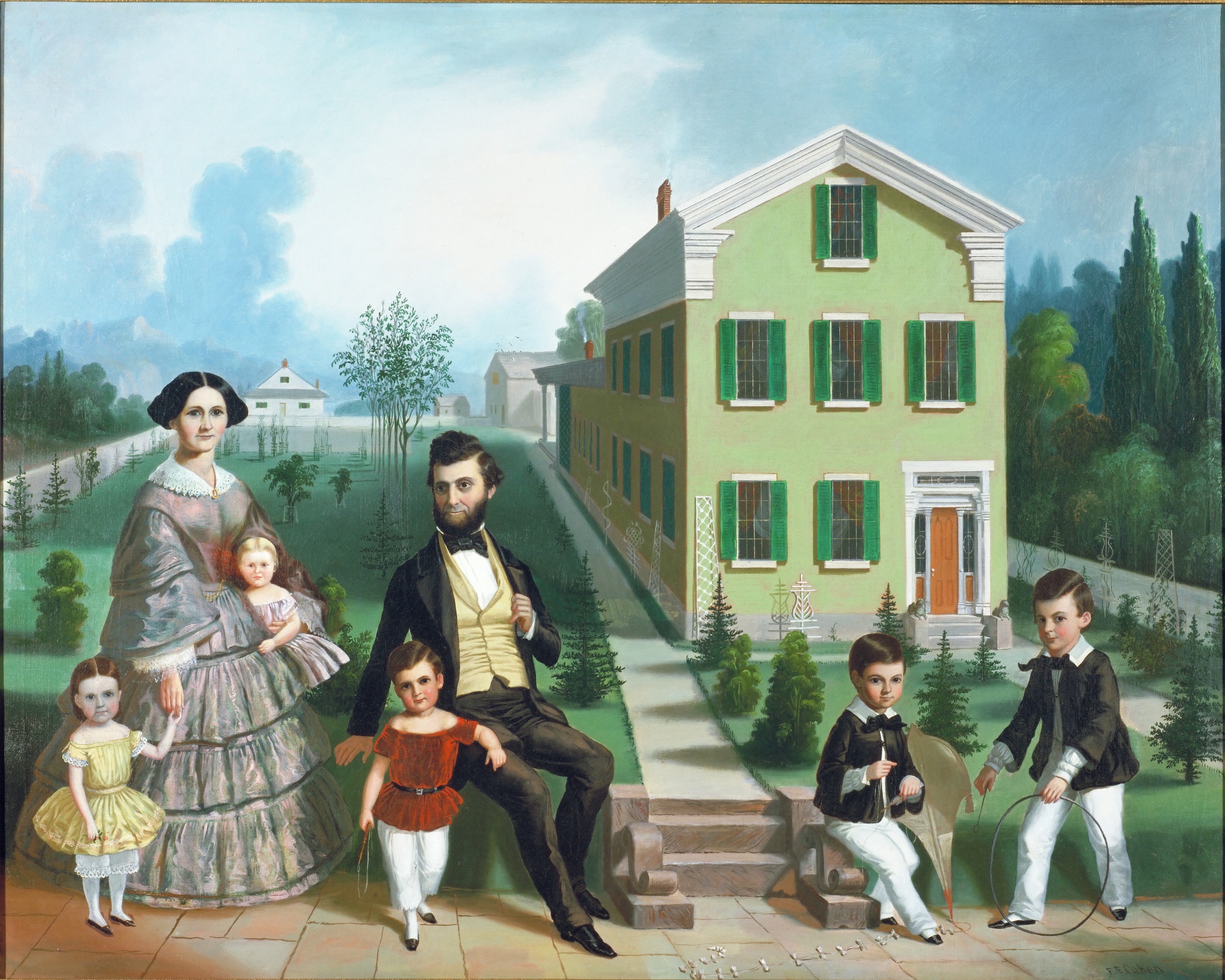
The Bentley Simons Runyan Family was given to the Allen Memorial Art Museum (AMAM), Oberlin College, in 1970 by Mary Parsons McCullough, granddaughter of Bentley Simons Runyan and a 1907 Oberlin College graduate. Beloved by museum visitors for its charming, perspective-defying treatment of the Runyan family and their property, the painting had long been accompanied by a label extolling Runyan’s contributions to Mansfield, a city about fifty miles southwest of Oberlin (fig. 2).
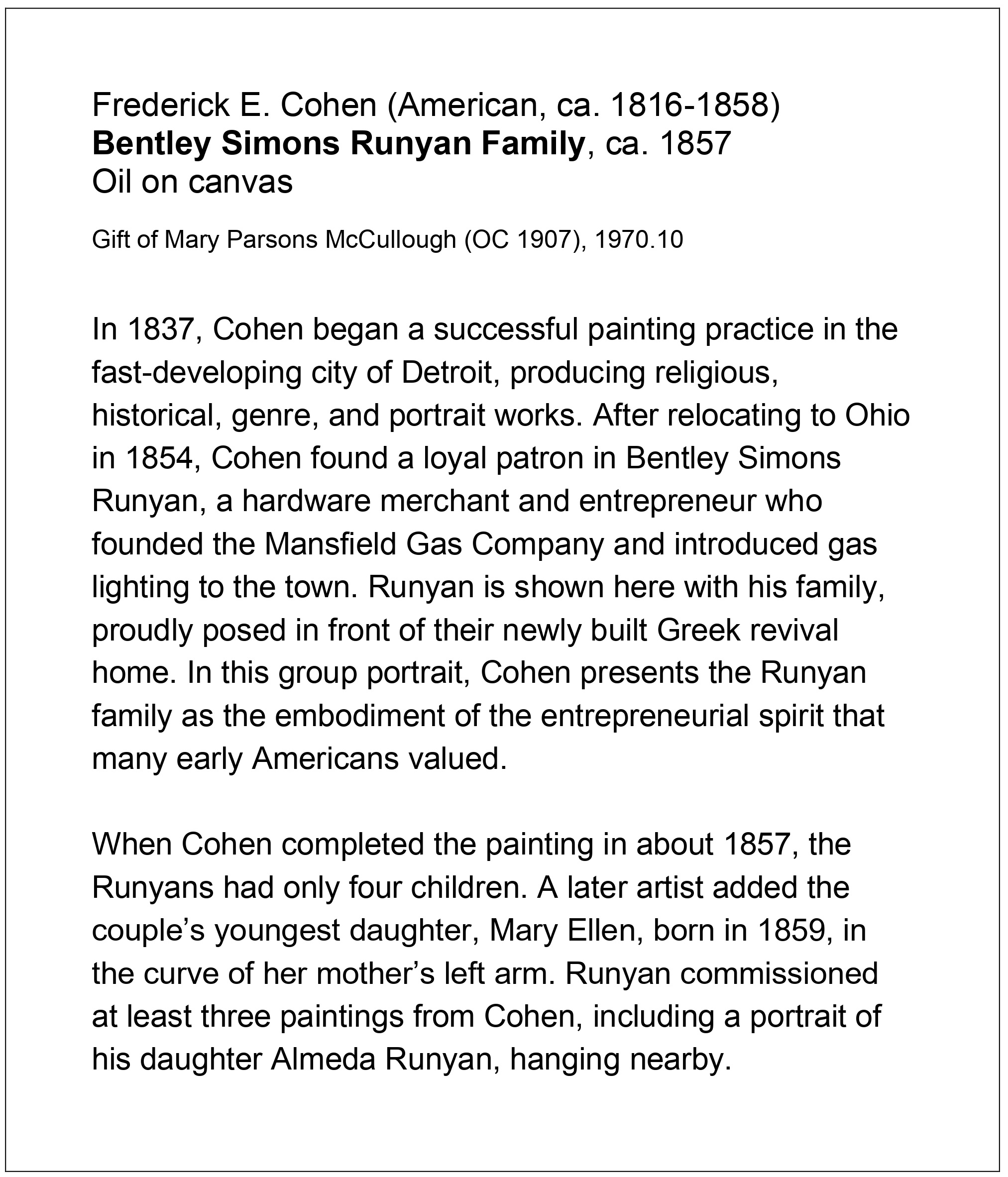
Over the past two years, this seemingly innocuous painting became a catalyst for reimagining curatorial and pedagogical strategies to address pressing issues in the museum field, including land acknowledgments, collecting histories, and settler colonialism. Through two collections-based projects—an iterative experimental installation and an exhibition—we recontextualized Euro-American artworks and Indigenous items from our collection and situated them within histories of Oberlin College and northeast Ohio. In the process, we grappled with the limitations of close looking and museum labels—two foundational tools of our profession—and experimented with alternative strategies for presenting historic works in our collection. Through these projects, we sought to create space to reevaluate our institutional histories and reimagine our roles as interpreters of museum collections.
The Trouble with Close Looking
Mansfield was founded in 1808 on land that the United States government seized as part of the 1805 Treaty of Fort Industry with the Wandat (Wyandotte), Odawa (Ottawa), Anishinaabe (Chippewa), Lenni Lenape (Munsee and Delaware), Saawankooki (Shawnee), and Bodewéwadmi (Potawatomi) nations—the treaty that also paved the way for the founding of Oberlin in 1833. Named after Jared Mansfield, surveyor general of the United States between 1803 and 1812, the town expanded substantially in the mid-1800s thanks to a new railroad connecting it to Sandusky on Lake Erie. By the time Runyan moved to Mansfield, it was booming; an 1856 map indicates that his house stood near the center of town (fig. 3).
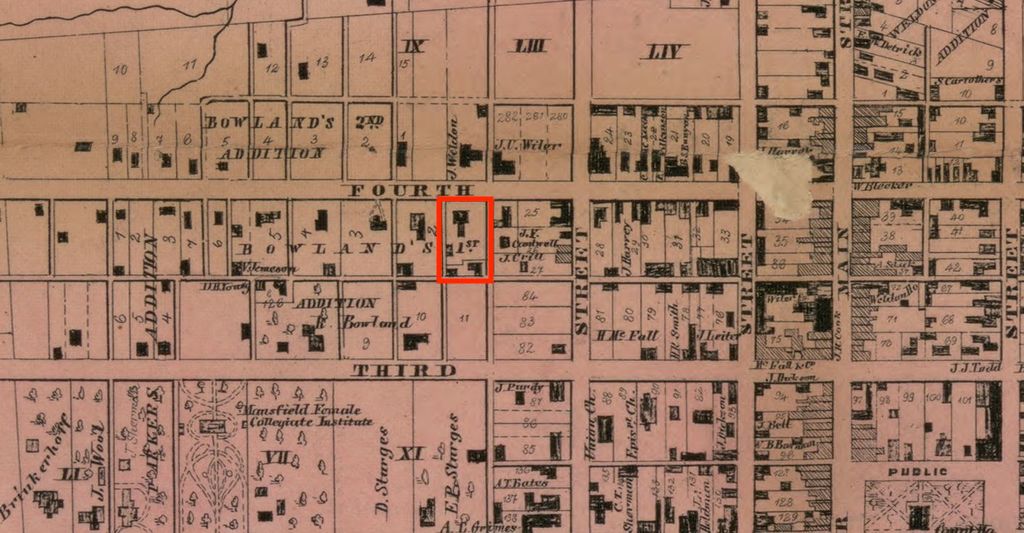
But Cohen depicts Runyan as if imposing order on land that was recently cleared for him. Indeed, while the painting’s current title foregrounds its human figures, it might also be characterized as a portrait of a house and the land on which it sits. This type of hybrid portrait would have been familiar to Cohen, an artist born in Britain. There he would have seen many examples of conversation pieces, the eighteenth-century genre of group portraiture popularized by William Hogarth.3 A comparison between Cohen’s painting and pictures depicting wealthy British families in front of their estates, such as Arthur Devis’s Robert Gwillym of Atherton and His Family (1745–47), reveals how Cohen presents the Runyans in the manner of landed European elites (fig. 4).
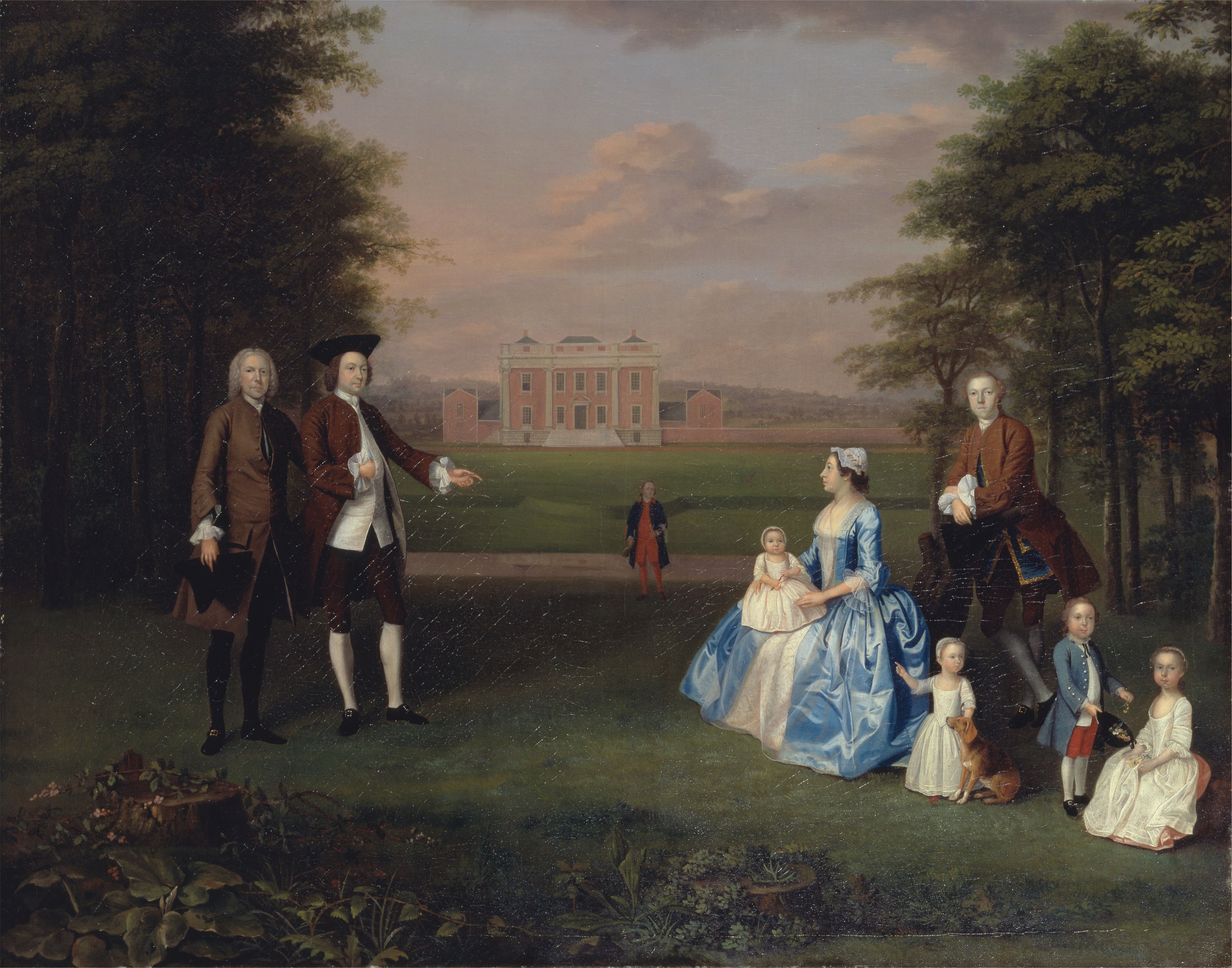
Portraits are—to quote Paul Staiti—“site[s] of dreams” that authenticate the narratives and ambitions of their sitters.4 This painting is no exception. But to accept this is to ignore how the painting functioned in 1857 as well as how it continues to operate on the walls of the museum today. As curators and educators at a teaching museum that works with thousands of students each year, we often rely on a process of close looking to ease students—especially those unaccustomed to talking about art—into more complex conversations. However, prioritizing visual details assumes that the most important evidence about an object can be discovered on its surface. By encouraging students to concentrate on and articulate their observations of the freshly cleared forest, budding plant life, and limitless blue sky, we began to wonder if close looking became a means of reinforcing Runyan’s and Cohen’s mindset about the land that is now Ohio by presenting white settlement of the region as something natural and optimistic. Were we using visual evidence, and specifically close looking, to support settler-colonial myths?5
Seeing Settler-Colonial Values in Oberlin
The story of the founding of Oberlin (both the city and the College) begins in 1832, when Presbyterian ministers John J. Shipherd and Philo P. Stewart were searching for land in northeast Ohio to establish a new Christian colony. The thirteen-acre Tappan Square, today in the center of Oberlin, just outside the museum, is the mythical location where the two prayed under an elm for God’s confirmation that they had found the perfect site. While they saw the land as vacant, unbroken wilderness, ready to be formed into their Christian utopia, it was and had been an active hunting ground of the Mingo and Wandat people who lived along the shores of Lake Erie.6
During a class visit to the museum in the fall of 2019, Professor of Biology Michael Moore urged his students to see Tappan Square as embodying the same vision as the Runyan painting: a fictive wilderness shaped by settler values. This provocation enabled us to recognize how the painting could be used productively as part of a land acknowledgment that addressed the ways in which our institution has been able to grow and thrive as a direct result of histories of dispossession. We created the DIS/POSSESSION project to probe what it means for an “encyclopedic” museum like the AMAM to write a land acknowledgment and how the process of doing so could transform our internal and external practices. The project’s primary public-facing element was an iterative installation that reevaluated and experimented with our interpretation of the collection, especially works made before 1900. Our introductory text presented the installation and its related programs as a prompt for conversations that would challenge us, individually and collectively, to consider what it means to acknowledge the land. Rather than present a single codified argument, each work in the installation was a starting point for exploration and self-reflection. We signed our labels to make our roles as interpreters transparent and be accountable for our potential misinterpretations of histories that we are still learning.
The first installation of the DIS/POSSESSION project investigated the role that American art has played in perpetuating myths about the land that reinforce a settler-colonial mindset. Rather than celebrate the Runyan family’s accomplishments, the painting’s new label addressed the Treaty of Fort Industry and its connection to Oberlin (fig. 5).7 The installation also included Carleton Watkins’s Yosemite Valley: Vernal and Nevada Falls from Glacier Point (negative dated to around 1865) and Andy Warhol’s Sitting Bull, from his Cowboys and Indians series (1986; fig. 6).
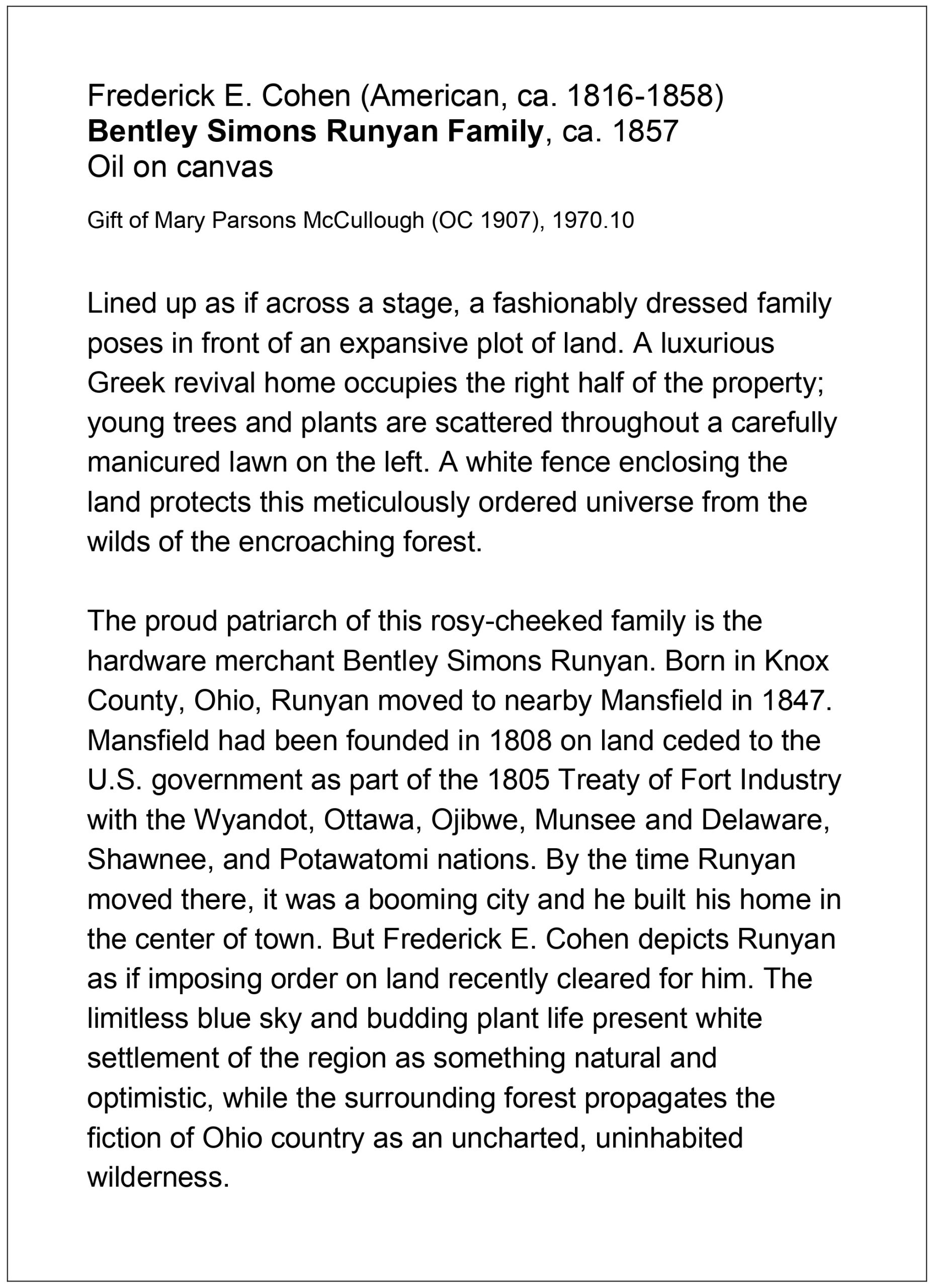
Extensive teaching and engagements with student groups in the installation allowed us to reassess how we facilitate conversations about these works and, by extension, about our collection more broadly. One of our key questions concerned when contextual information should be provided to complicate students’ initial visual impressions of a work. Though some viewers were able to see the potential violence of Warhol’s Pop aesthetic transforming the face of the revolutionary Húŋkpapȟa Lakhóta (Hunkpapa Lakota) leader Thatháŋka Íyotaka (Sitting Bull), more complex conversations emerged when students learned that Warhol’s screen print was based on an 1881 image that Thatháŋka Íyotaka charged the photographer Orlando Goff fifty dollars to take.8 The screen print thus became an avenue for highlighting Thatháŋka Íyotaka’s awareness of nineteenth-century US audiences’ desire to possess his likeness, which enabled a broader discussion of how sovereignty and representation are closely intertwined. Warhol’s image was even more provocative in light of the fact that the Cleveland baseball team had just retired its racist mascot, Chief Wahoo, after fifty years of protest by local Indigenous activists, including many in Oberlin.

Framed as an investigation and not a final product, DIS/POSSESSION created space for iteration and communal discovery. It invited students to ground theoretical ideas often encountered in coursework in object-based case studies and allowed audiences to revisit familiar works anew. We hoped that the ongoing questioning and introspection we modeled would impact how students and visitors looked at the world beyond the museum. In one instance, two student athletes who visited with a class “wanted to apply the principles talked about in the exhibition . . . to something in our own lives” by researching the history of lacrosse, which they had played since childhood without knowing its Indigenous origins.9 They shared their research through the lacrosse team’s social media accounts, where they urged followers to donate to Indigenous organizations.
Making Our Colonial History Visible
In the spring installation of DIS/POSSESSION, we experimented with making institutional and collecting histories transparent. We included the Uhunmwun-Ekhue (Leopard hip ornament)—which was looted by the British army during their 1897 military campaign, motivated in part by Benin’s natural resources—not to discuss questions of restitution but to focus on how the object came to the museum.10 By putting it into conversation with a seventeenth-century Dutch portrait purchased with funds bequeathed by AMAM founder Mrs. Elisabeth Severance Prentiss, whose fortune came from Standard Oil, we tied these objects’ stories to the history of our own institution (fig. 7). Rather than encouraging close looking or providing historical context, our labels revealed the extractive practices that made the acquisition of these works possible. Each label ended with a question that invited scrutiny of collecting practices to make clear how the colonial plunders of natural and cultural resources are intertwined. The function of the works in the installation thus shifted: instead of being the source of information, their presence created an atmosphere that, we hoped, signaled the museum’s willingness for honest dialogue about its history and collecting practices.
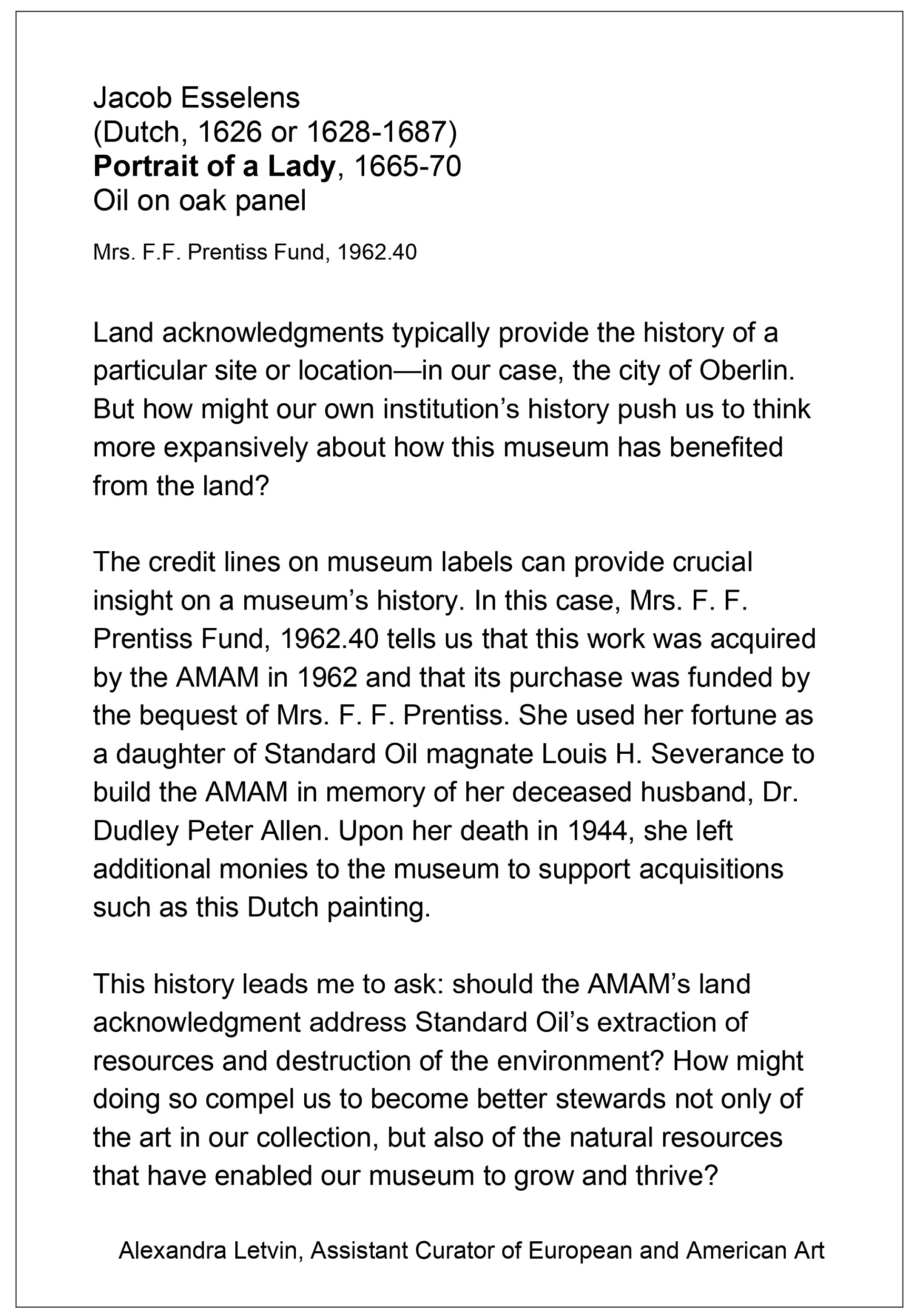
The third iteration of DIS/POSSESSION, subtitled Divergent Paths, reconstructed the opaque history of the largest portion of the museum’s collection of items by Indigenous North American makers, which was transferred to the AMAM from the College’s department of zoology. The items were once part of a natural history collection used for hands-on teaching that was established in 1859 by George Nelson Allen, Professor of Sacred Music and Geology. When the collection was dispersed in 1957, hundreds of ethnographic items not accessioned into the AMAM were left without formal institutional oversight until the anthropology department began to care for them in the early 2000s.11 The exhibition put two pairs of moccasins, likely collected from the Plains around the same time, on display next to one another, separated by a timeline charting their known afterlives. The introductory text asked visitors to reflect on how Oberlin came to possess them and how we, as a campus community, can ethically approach their future stewardship.
Our fall 2022 exhibition Objects of Encounter: American Myths of Place built on insights from DIS/POSSESSION to push our reinterpretation of the collection further by making collecting histories visible, highlighting Indigenous agency and sovereignty in the face of colonialism, and foregrounding reflection on our own roles—as individuals and as an institution—in these processes.12 Though Objects of Encounter sketched out a broader story, we wove in histories of Oberlin and its alumni in the labels. The exhibition began with the AMAM’s 1909 Thomas Moran painting of the Grand Canyon, a place the artist first saw in 1873 when he joined an expedition to its northern rim with John Wesley Powell, who attended Oberlin and went on to become the head of the US Geological Survey and the Smithsonian’s Bureau of Ethnology.13 The label highlighted this historical connection while also urging viewers to consider how Moran’s imposing view visualized elements of Powell’s belief that the inferior status of Indigenous Peoples justified seizing their land. At the center of the gallery, a case containing the journal of field notes and photographic albums of a student on a 1915 Oberlin College ecology trip to the Pacific Coast raised questions about the power dynamics of experiential learning, which continues to be a central part of the curriculum. The materials were created as part of a class project studying seabirds during which two hired qʷidiččaʔa·tx̌ (Makah) guides helped the students learn how to navigate and traverse treacherous land and waterways. The label quoted from the student’s journal to reveal how she framed Indigenous subjects as gateways to authentic experiences with the land.
The exhibition also included several ledger drawings that had long been celebrated as a collection highlight but whose violent collecting histories had never been addressed. Most of the drawings were made by the Tsitsistas (Southern Cheyenne) warrior Ho’néohnéstoohe (Howling Wolf) in the winter of 1874/75 before he was imprisoned at Fort Marion in St. Augustine, Florida.14 The exact circumstances under which Ho’néohnéstoohe’s drawings left his possession and entered into a chain of ownership that eventually brought them to Oberlin in 1904 is the topic of ongoing research, but we know they were collected by a US military scout. In 1999, another ledger drawing by Sičháŋǧu Lakhóta (Brulé Lakota) warrior and visionary Thatháŋka Ptéčela (Short Bull) was gifted to the museum, in part, because of the presence of Ho’néohnéstoohe’s drawings. The brutal history of this sheet’s initial acquisition is clear from a dated dedication on its reverse (fig. 8). It was purchased directly from Thatháŋka Ptéčela in 1891 while he was imprisoned at Fort Sheridan, Illinois, and given to two children, aged five and eight.
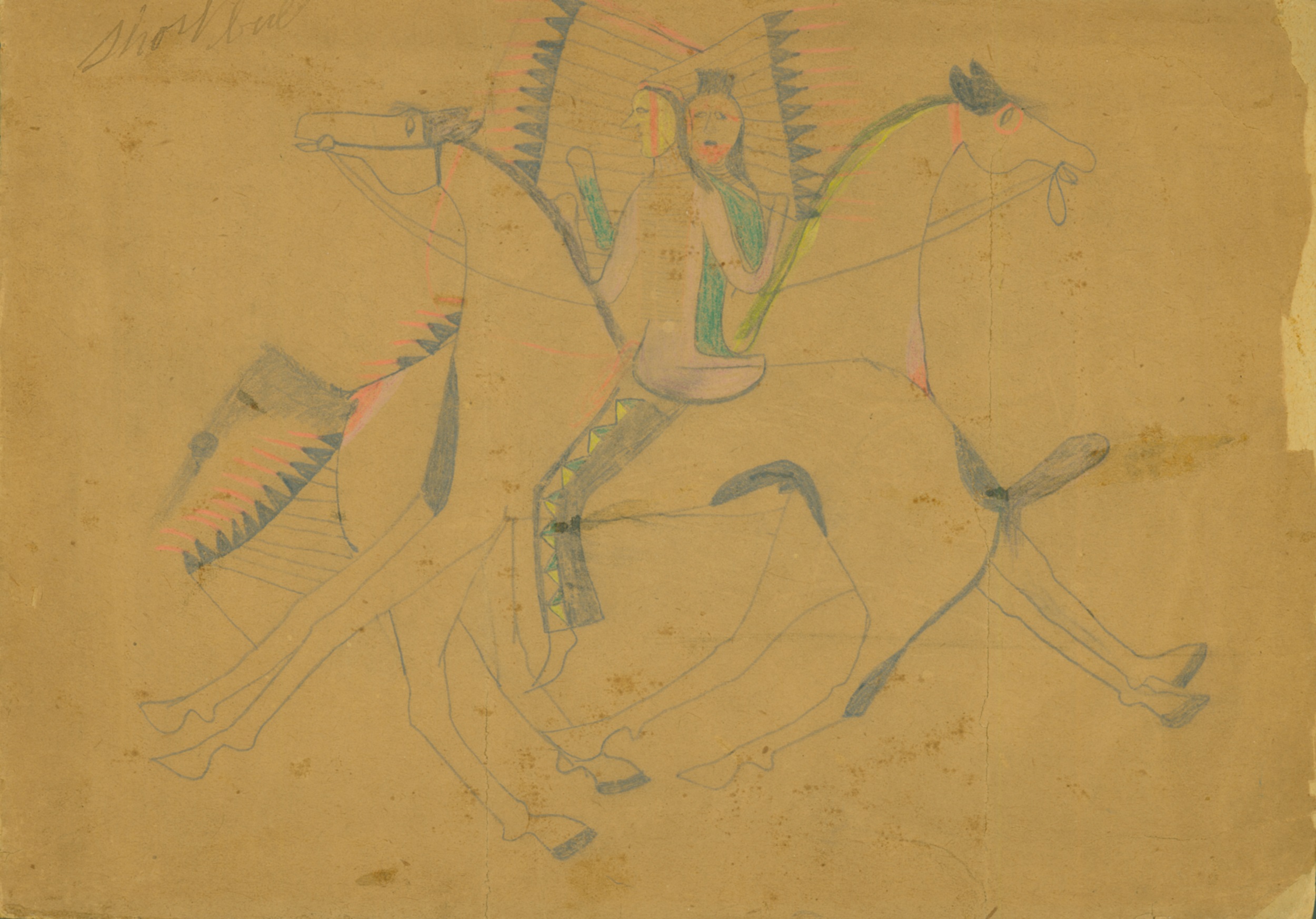

Foregrounding this story in the label encouraged scrutiny of the inscription that domesticated and commodified Thatháŋka Ptéčela’s resistance into an object for children. Close looking was therefore a tool for recognizing how the violent histories of colonialism were inscribed on this object. Directly asking how these ledger drawings arrived at the museum forced us to consider how not telling the story of Ho’néohnéstoohe’s dispossession in previous forms of interpretation perhaps brought Thatháŋka Ptéčela’s painful story to us.
Reevaluating Histories to Create New Futures
Breaking apart the Runyan family portrait’s fiction and putting it into conversation with the land just outside the museum was a gateway to our larger reevaluation of museum interpretation and reconsideration of our institution’s history. By questioning the function of labels as simple invitations to look closer, we came to see them instead as places to reflect vulnerably on challenging histories and to signal the importance of speaking openly about them in our galleries. This process of introspection transformed our understanding of the work museum interpretation can and should do in historic collections.
Rethinking how labels and close looking operate was only possible because of our iterative and collaborative approach. The two years spent working with a select number of objects allowed us to proceed with care and humility as well as to listen in new ways. This provided the opportunity for slow—rather than close—looking with and through the perspectives, insights, and questions of others. Slowing down allowed counternarratives that always existed in these works to come into clearer focus for us, while also creating space for our audiences, colleagues, and selves to adjust to these evolving approaches to interpretation. While much work remains to recatalogue, reinterpret, and relearn our collections, these temporary installations, exhibitions, and programs laid the groundwork for a broader transformation of the narratives we address in our galleries and teaching. On a personal level, these projects led us to reevaluate our roles as interpreters of collections and embrace the museum as a place for asking rather than answering questions.
Cite this article: Hannah Wirta Kinney and Alexandra Letvin, “Interpretation as Introspection: Transforming Narratives of American Art at the Allen Memorial Art Museum,” Panorama: Journal of the Association of Historians of American Art 9, no. 1 (Spring 2023), https://doi.org/10.24926/24716839.17250.
Notes
- Christopher Busta-Peck, “In Search of the Bright Green House—The Bentley Simons Runyan Family of Mansfield, Ohio,” Cleveland Area History, December 14, 2012, http://www.clevelandareahistory.org/2012/12/in-search-of-bright-green-house-bentley.html. ↵
- Little is known of Cohen’s early life before his arrival in Detroit in the 1840s. The most comprehensive account of his life and career is Anastasia Kinigopoulo, “The Grotesque Visions of a Genteel Rogue: Frederick E. Cohen’s Detroit Paintings, 1845–1853” (master‘s thesis, University of Delaware, 2020). See also Marcia Goldberg, “Frederick E. Cohen,” in Artists of Michigan from the 19th Century, ed. J. Gray Sweeney et al. (Muskegon, MI: Muskegon Museum of Art, 1987), 56–61. ↵
- On the development of this genre, see Kate Retford, The Conversation Piece: Making Modern Art in Eighteenth-Century Britain (New Haven, CT: Yale University Press, 2017). ↵
- Paul Staiti, “Accounting for Copley,” in John Singleton Copley in America, ed. Carrie Rebora, Paul Staiti, Erica E. Hirshler, Theodore E. Stebbins Jr., and Carol Troyen (New York: Metropolitan Museum of Art, 1995), 25–51, 35. Our research and thinking about this painting was shaped by conversations Letvin had with Carrie Rebora Barratt, Mindy Besaw, Wendy Castenell, and Margarita Karasoulas as a Tyson Think Tank Fellow at the Crystal Bridges Museum of American Art in 2021. ↵
- Martin A. Berger, “The Problem with Close Looking,” in A Companion to American Art, ed. John Davis, Jennifer A. Greenhill, and Jason D. Lafountain (Chichester: John Wiley, 2015), 113–27; Jennifer A. Greenhill, “Response: Look Away,” in Davis et al., Companion to American Art, 128–45. ↵
- An August 2022 report on the presence of Indigenous Peoples in Oberlin before 1833, written by Sundance, executive director of Cleveland American Indian Movement, as well as many conversations with him, have deepened our understanding of the long history of what is today northeast Ohio. ↵
- In the spirit of vulnerability that we sought to model throughout this project, we are sharing the first label that we wrote as part of DIS/POSSESSION. It captures an early moment in our learning process. Through conversations with our audiences, we came to recognize the many problems remaining in the label, particularly our use of colonizers’ names for Indigenous groups and the words we used to describe the complex power dynamics of treaties. ↵
- Faith Brower, “Sitting Bull,” catalogue entry in Warhol and the West, ed. heather atone, Faith Brower, and Seth Hopkins (Oakland, CA: University of California Press, 2019), 124–27; Louis N. Hafermehl, “Chasing an Enigma: Frontier Photographer Orlando S. Goff,” North Dakota History 81, no. 2 (Summer 2016): 19; Markus H. Lindner, “Family, Politics, and Show Business: The Photographs of Sitting Bull,” North Dakota History 72, nos. 3 and 4 (Summer 2005): 4–5. ↵
- Oberlin College Women’s Lacrosse team (@yeo_wlax), Instagram post, May 26, 2022. ↵
- The website Digital Benin (digitalbenin.org) provides rich content on the history of these objects and their looting, including an extensive bibliography. ↵
- Amy Margaris, Associate Professor of Anthropology, is writing a book on revitalizing cultural heritage collections and has generously shared her research on the history of Oberlin College’s collections with us. ↵
- This exhibition was collaboratively curated with Lucy Haskell, curatorial assistant for academic programs, and Audrey Libatique, student curatorial assistant in European and American art. ↵
- Joni Louise Kinsey, Thomas Moran and the Surveying of the American West (Washington, DC: Smithsonian Institution Press, 1992), 95–137. F. Zeb Page, Professor of Geosciences, first shared with us Powell’s connection to Oberlin and the Geoscience Department’s rethinking of his legacy. ↵
- Joyce M. Szabo, “Howling Wolf: An Autobiography of a Plains Warrior-Artist,” Allen Memorial Art Museum Bulletin 46, no. 1 (1992): 4–22; Joyce M. Szabo, Howling Wolf and the History of Ledger Art (Albuquerque, NM: University of New Mexico Press, 1994), 175–88 (on the drawings now in the AMAM). ↵
About the Author(s): Hannah Wirta Kinney is curator of academic programs at the Allen Memorial Art Museum, Oberlin College. Alexandra Letvin is the Duane Wilder, Class of 1951, Associate Curator of European Art at the Princeton University Art Museum and was formerly assistant curator of European and American art at the Allen Memorial Art Museum, Oberlin College.

